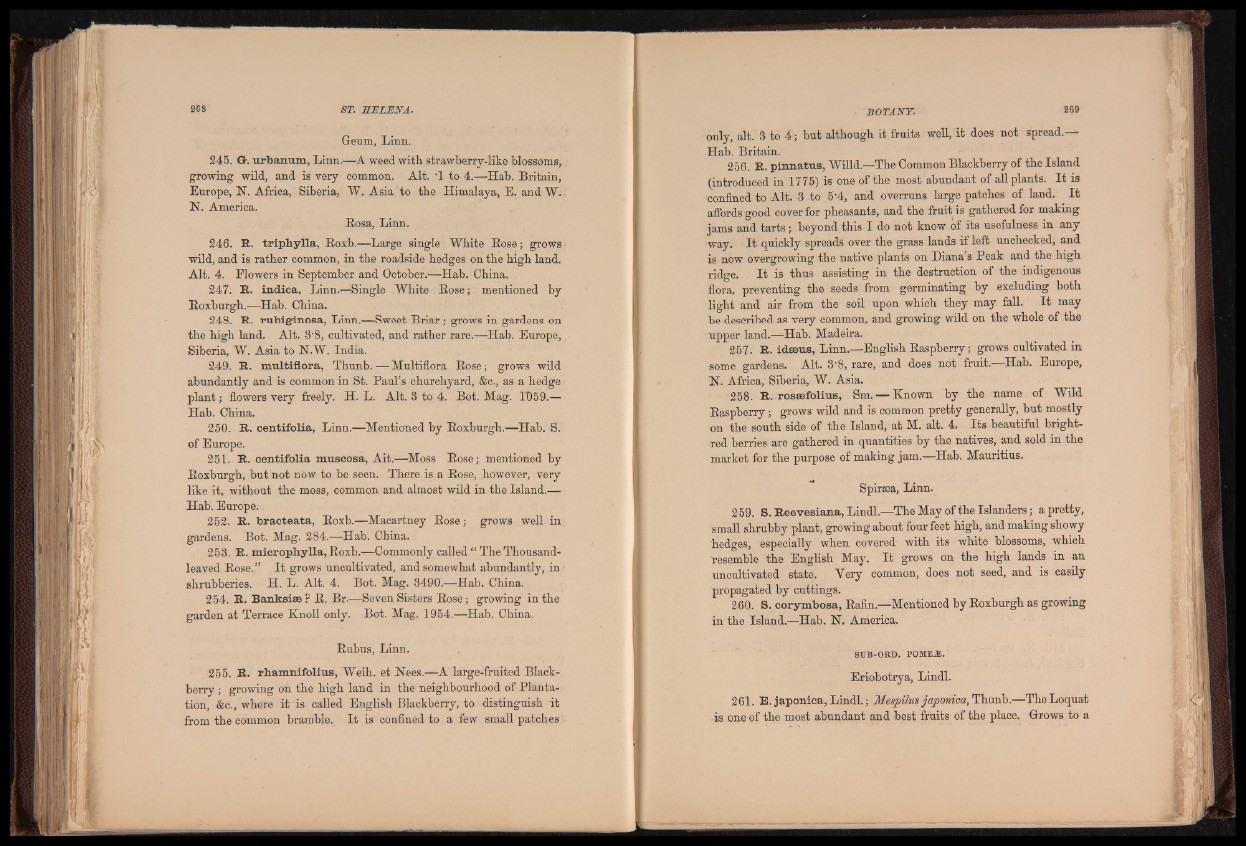
Geum, Linn.
245. Q. urbanum, Linn.—A weed with strawberry-like blossoms,
growing wild, and is very common. Alt. -1 to 4.—Hab. Britain,
Europe, N. Africa, Siberia, W. Asia to the Himalaya, E. and W.
N. America.
Rosa, Linn.
246. R. triphylla, Roxb.—Large single White Rose; grows
wild, and is rather common, in the roadside hedges on the high land.
Alt. 4. Flowers in September and October.—Hab. China. .
247. R. indica, Linn.—Single White Rose; mentioned by
Roxburgh.—Hab. China.
248. R. rubiginosa, Linn.—Sweet Briar ; grows in gardens on
the high land. Alt. 3-8, cultivated, and rather rare.—Hab. Europe,
Siberia, W. Asia to H.W. India.
249. R. multiflora, Thunb. — Multiflora Rose; grows wild
abundantly and is common in St. Paul’s churchyard, &c., as a hedge
plant; flowers very freely. H. L. Alt. 3 to 4. Bot. Mag. IT)59.—
Hab. China.
250. R. centifolia, Linn.—Mentioned by Roxburgh.—Hab. S.
of Europe.
251. R. centifolia muscosa, Ait.—Moss Rose; mentioned by
Roxburgh, but not now to be seen. There is a Rose, however, very
like it, without the moss, common and almost wild in the Island.—
Hab. Europe.
252. R. bracteata, Roxb.—Macartney Rose; grows well in
gardens. Bot. Mag. 284.—rHab. China.
253. R. microphylla, Roxb.—Commonly called “ The Thousandleaved
Rose.” I t grows uncultivated, and somewhat abundantly, in -
shrubberies. H. L. Alt. 4. Bot. Mag. 3490.—Hab. China.
254. R. Banksise ? R. Br.—Seven Sisters Rose; growing in the
garden at Terrace Knoll only. Bot. Mag. 1954.—Hab. China,
Rubus, Linn.
255. R. rhamnifolius, Weih. et Nees.—A large-fruited Blackberry
; growing on the high land in the neighbourhood of Plantation,
&c., where it is called English Blackberry, to distinguish it
from the common bramble. I t is confined to a few small patches
only, alt. 3 to 4 ; but although it fruits well, it does not spread.—
Hab. Britain.
256. R. pinnatus, Willd.—The Common Blackberry of the Island
(introduced in 1775) is one of the most abundant of all plants. I t is
confined to Alt. 3 to 5‘4, and overruns large patches of land. I t
affords good cover for pheasants, and the fruit is gathered for making
jams and ta rts ; beyond this I do hot know of its usefulness in any
way. I t quickly spreads over the grass lands if left unchecked, and
is now overgrowing the native plants on Diana s Peak and the high
ridge. I t is thus assisting in the destruction of the indigenous
flora, preventing the seeds from germinating by excluding both
light and air from the soil upon which they may fall. I t may
. be described as very common, and growing wild on the whole of the
upper land.—Hab. Madeira.
257. R. idseus, Linn.—English Raspberry; grows cultivated in
some gardens. Alt. 3'8, rare, and does not fruit.—Hab. Europe,
N. Africa, Siberia, W. Asia.
258. R. rossefolius, Sm. — Known by the name of Wild
Raspberry; grows wild and is common pretty generally, but mostly
on the south side of the Island, at M. alt. 4. Its beautiful bright-
red berries are gathered in quantities by the natives, and sold in the
market for the purpose of making jam.—Hab. Mauritius.
Spiraea, Linn.
259. S. R eevesiana, Lindl.-4The May of the Islanders; a pretty,
small shrubby plant, growing about four feet high, and making showy
hedges, especially when covered with its white blossoms, which
resemble the English May. I t grows on the high lands in an
uncultivated state. Very common, does not seed, and is easily
propagated by cuttings.
260. S. corymbosa, Rafin.—Mentioned by Roxburgh as growing
in the Island.—Hab. N. America.
SU B -O RD . POME.®.
Eriobotrya, Lindl.
261. E.japonica, Lindl.; Mespilus japonica, Thunb.—TheLoquat
is one of the most abundant and best fruits of the place. Grows to a